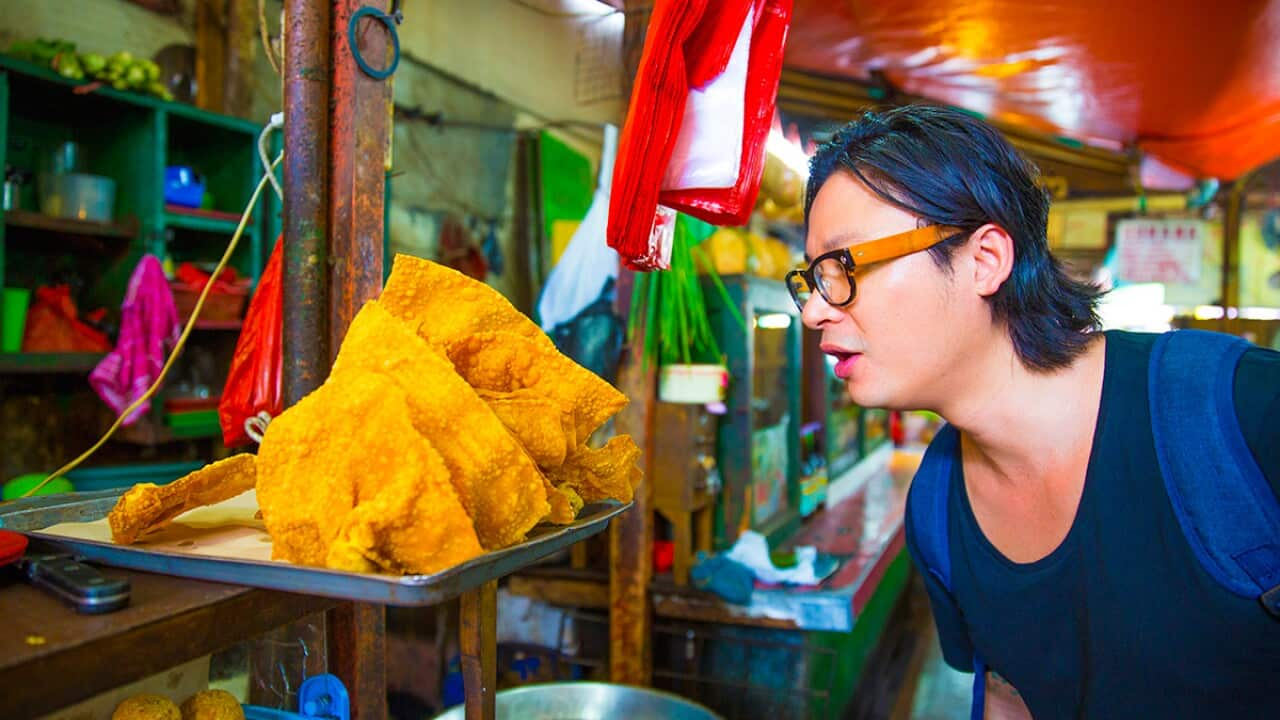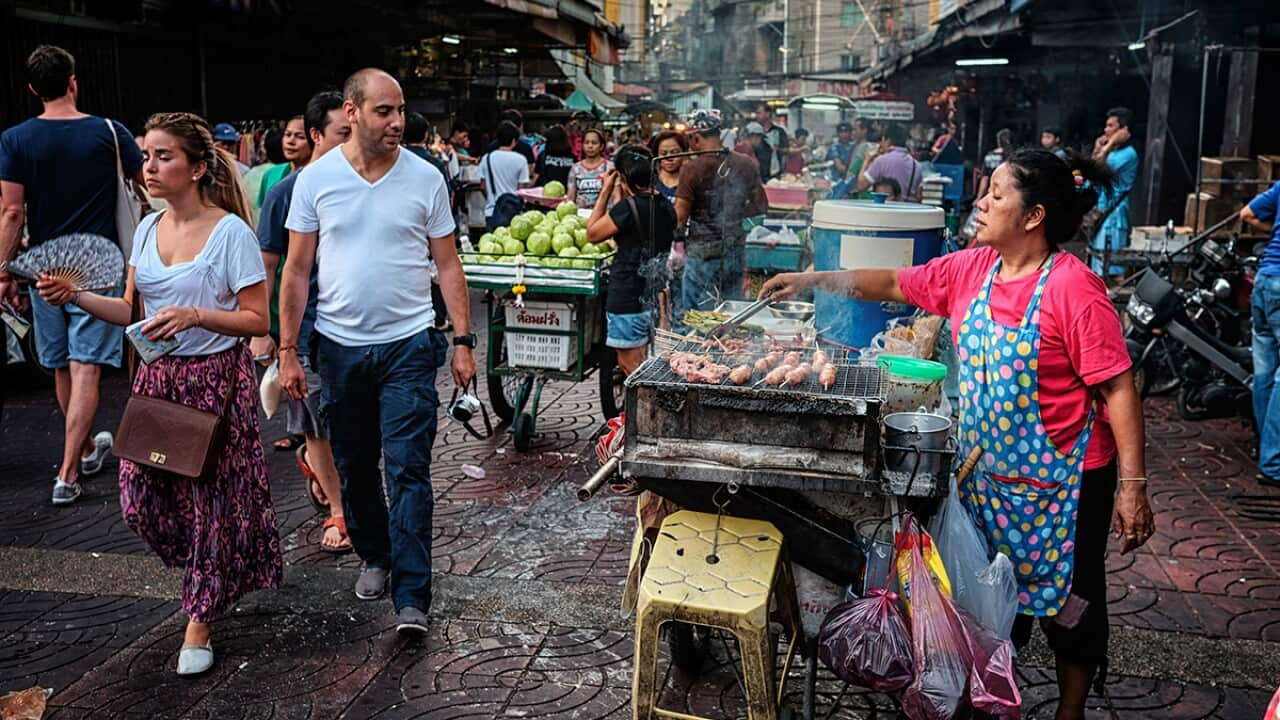What did you love about this new series compared with your previous adventures? I love the style of this series, it was kind of like boom, boom, boom and then you [the viewer] are like wow, I want to go there. I spent so much time researching, so much time in these locations and meeting the people, I just wanted to show as much as I could, expose the food and culture as best I could. So street food is something that should be valued? I think street food is where you get a good sense of the culture, the cuisine, of course, and a great way to get in touch with the local people as well. What would you say to those street food novices out there, any tips? Always eat where you see a lot of people - a popular place with a high turnover. I also like to eat at places where you can see everything cooked right in front of you and that is the beauty of street food, you’re there and the cooks are there with their burner, their pot or their wok, all the ingredients laid out in front of them. There’s no back kitchen, [it’s] an open kitchen on the street, so you see everything. Look at the ingredients, what proteins they are using, how fresh it looks, the vegetables … what does it look like – look at your food and ingredients, just like you would when you go shopping in a supermarket. Look for fresh and vibrant produce. I always eat street food that is very close to a market so I know that’s where they buy their ingredients from and more often than not they are near a market.
What would you say to those street food novices out there, any tips? Always eat where you see a lot of people - a popular place with a high turnover. I also like to eat at places where you can see everything cooked right in front of you and that is the beauty of street food, you’re there and the cooks are there with their burner, their pot or their wok, all the ingredients laid out in front of them. There’s no back kitchen, [it’s] an open kitchen on the street, so you see everything. Look at the ingredients, what proteins they are using, how fresh it looks, the vegetables … what does it look like – look at your food and ingredients, just like you would when you go shopping in a supermarket. Look for fresh and vibrant produce. I always eat street food that is very close to a market so I know that’s where they buy their ingredients from and more often than not they are near a market.

Luke Nguyen tastes the offerings at Madras Lane in Kuala Lumpur. Source: Luke Nguyen's Street Food Asia
Is there anything else you do with your dishes that you would recommend? Well, when ordering soups you want to see the soup simmering away, see the noodles blanched in hot water, that all the ingredients are fresh, everything is cooked right there in front of you. If you are ordering a pho, for example, you will get a plate of condiments – bean sprouts, fresh mint, coriander etcetera - I always get them to quickly blanch them for me, too. It does help a lot with hygiene and you can see it happening in front of you and this is something that usually works for me when ordering soup.
Early on in the series you briefly mention how the authorities patrol the streets and markets in Saigon and approach vendors to move along. How does this impact the street food culture? In Vietnam street food is getting harder and harder to find. Because street food vendors are sometimes getting kicked out of certain areas, it can be difficult. For the locals, we love street food and in cities like Bangkok, KL and Jakarta there is such a massive street food scene and I do wish that in Saigon they could have fixed areas where street food is fine to be sold without interruption. So having authorities intervening doesn’t have to be looked at negatively. To a certain extent I do understand the reasons behind the authorities [intervening]. For example, if all the vendors are setup on the footpath there’s nowhere to walk.There had been so many times whilst we were filming, I would be sitting down, enjoying a meal curb-side and then the authorities would come and all the guests had to get up. They had to move all their tables and then set it all up again. It can be quite exciting, but it’s not fun when they [the street vendors] get caught and everything’s been confiscated, that’s not fun. If they don’t run or move fast enough, then everything gets taken into the police station. And so, they have two choices, they come pay a fine and pay for everything to come out again and take it home OR they lose everything. That’s why they invest in plastic chairs, plastic tables, cheaper and older furniture, because these things can be expensive especially if they are to lose something like that.
How is street food culture different in the other cities compared to Saigon? In KL there’s many streets and stalls, that’s what they're known for, street food. And the government allows them to do it. (In Vietnam) it’s just the smaller vendors that are on bicycles and on carts and that’s the reason they are on a cart, so that they’re moveable - they can move around quickly when the authorities come. Which kind of makes it fun and exciting, too, but it does make their job harder. What I love about what I found in Saigon was that street in the morning where I was having breakfast - Cô Giang. Certain areas work for street foods during certain times – so from 6am – 8am this area comes alive. Then the vendors will move to another location, maybe where a school is starting at a certain time and so that works for them, as they are always mobile. In one morning they can do several different locations. They’re kind of chasing their clientele, like a food truck - certain times, certain rushes and they just move to those locations as they need to. It’s similar to our food truck culture here; Asia has been doing it for centuries.
Was there anything in the series that challenged your tastebuds? Jakarta and drinking that jamu was the only thing – because it was so unexpected. The reason being is because I learnt about jamu the morning before we were filming. I was at my hotel and there was this drink called jamu and I was like “what is it”? I was told it was a traditional medicinal drink and that it was really nice - it had a bit of honey in there, ginger, turmeric and all the aromatics. And so, I was like ‘oh this is not so bad’. Little did I know that was the western, toned down, honey-sweetened version. When I had it on the street I was like ‘wow! This is the real-deal’. One, I was expecting something different and two, this was like drinking herbal medicine, and it was full-on and I couldn’t hide it. That is what jamu really is. Would I try it again... eh, I’m not sure. So not your go-to drink? No, it won’t be my go-to drink. It was interesting to try the ‘tourist’ version versus the local version. Locals try to drink it because it is meant to be very medicinal and good for you and give you a boost for the day. There are certain jamus for certain people, there’s jamus specific for men and for women. Yeah it was an interesting drink, interesting concept. You also tasted turtle in Jakarta – how did you find it? Ah, that was another thing, it is an acquired taste – because turtle’s got gristle in it, it’s quite crunchy and a little bit chewy at the same time. So, textural-wise it’s really interesting, I liked it, but I think for a lot of people, they may go ‘oooh, I don’t know about that’. Another dish, in Bangkok, which people might go ‘I’m not too sure about’ is . And with the boat noodle, as they spoon up your broth and noodles, they also pour pig’s blood through it – so, not congealed pig’s blood, real, runny blood, so that it coagulates slightly into the soup. So that was an interesting dish that is also an acquired taste.
You also tasted turtle in Jakarta – how did you find it? Ah, that was another thing, it is an acquired taste – because turtle’s got gristle in it, it’s quite crunchy and a little bit chewy at the same time. So, textural-wise it’s really interesting, I liked it, but I think for a lot of people, they may go ‘oooh, I don’t know about that’. Another dish, in Bangkok, which people might go ‘I’m not too sure about’ is . And with the boat noodle, as they spoon up your broth and noodles, they also pour pig’s blood through it – so, not congealed pig’s blood, real, runny blood, so that it coagulates slightly into the soup. So that was an interesting dish that is also an acquired taste.

Luke gets his hands around some jamu, although he might not be as happy as the vendor once he tastes it... Source: Luke Nguyen's Street Food Asia
What you need to know

Breakdown: Thai boat noodle soup
How did language play a part in your street food experiences? I just approached (street food) like I’m any traveller. When I travel to a certain country, I think I’ve got to give the country and the people a little bit of respect by learning a little bit. Do a bit of homework and learn the basics, 1,2,3,4,5… ‘thank you’, ‘hello’, ‘good morning’, ‘delicious’ etcetera - the basics needed to travel a country. As a traveller, you need to be able to do that to converse slightly and the rest is just organic, I guess, it just goes with the flow and it happens. And I love that part of travelling and being able to communicate with the locals however you can – through words you have picked up, through signs, or just laughing!
When you’ve got that and the passion for food, I think the language of food speaks out really well for both parties. It’s interesting what you can come up with when you’re doing sign language and talking about certain dishes, it’s actually quite funny and I think that’s a good way to kind of break the ice a little bit between you and the local people and the local vendors.
airs Thursdays at 8.30pm on SBS and then on . Visit the for recipes, information and more.




